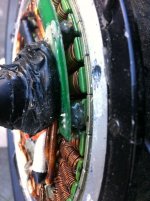mr.electric wrote:
Yes I have a mac on my bench now. There are certainly differences. I'm thinking of trying to use the threaded holes that already exist in the stator and just drilling the the cover. It appears to be about a 3" circle. A custom heat bridge would be needed too.
The stator is such cheap pot metal that it may be good to use some type of steel insert if one planned on assembling and disassembling numerous times.
The Mac I have has a noticeable tilt to the metal retainer plate screwed into the stator. It looks like the Philips screws that hold it in place were driven in with reckless abandon. This makes me wonder if the threads underneath are still any good. I may have to drill out and rethread either way.
Whiplash,
Any ideas on how to drill a circular pattern of holes on a drill press without use of an indexed table or other fancy machine tools. I have a caliper , scribe hand tools.


